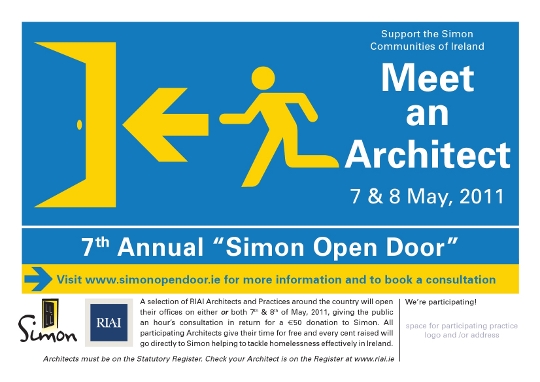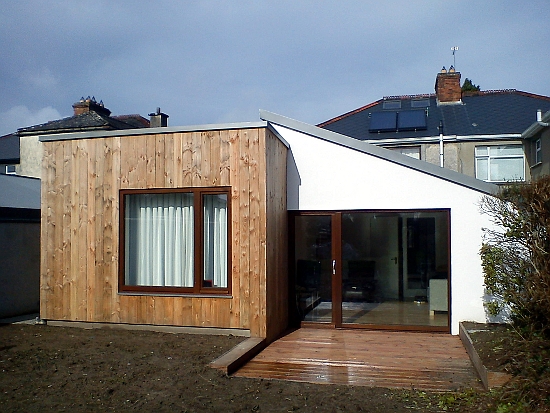ZERO WASTE by O'Neill Architecture.
"Receiving a 'Highly Commended' in the RIAI Emerging Practice Award has given us
the confidence to persevere in an industry that still needs to improve the environmental contribution it could be making"
Friday, December 23, 2011
RIAI Annual Review, Irish Architecture, Vol 2
Thursday, November 10, 2011
Thursday, September 22, 2011
House on the Curve - As seen on TV 'About the House' 22nd November 2011 RTE 1 at 8.30pm
Friday, September 2, 2011
Sunday, August 28, 2011
Friday, July 8, 2011
Limerick Chronicle newspaper article 14th June 2011
A house in Limerick city, which was redesigned by architect Patti O'Neill, and has been shortlisted for a prestigious RIAI award
Wednesday, June 29, 2011
House on the Curve - Architect's Imagination
It's 8pm mid summer. All is quite, the workmen have gone home. I am alone in the new space. There is movement behind the curved wall; kids playing on the square, people and cars passing occasionally. Already I get the sense of protection the curved wall will offer although for now I hear the sounds. There is a big distraction through the sun rays glowing in the space. It's exciting. As architects we design these spaces, we imagine what they will look like and feel like, we anticipate the effects of light throughout the day, we consider the views and carefully select the materials. The process is a long one and for a long time it is in our imagination. So we create it and we own it. Until such time when it is built. And even during that process it is still ours until just about now. This evening it still feels like mine even though I know from now on I'll be handing it over.
Thursday, June 23, 2011
Friday, May 13, 2011
House on the Curve - Nenagh
1st week on-site. Willie McGrath (man with hard-hat) of McGrath Construction built the houses of this estate 10 years ago. A passer-by stated 'you built the place now you're taking it apart!'
Wednesday, May 4, 2011
Simon Open Door on 7th & 8th May
Friday, April 22, 2011
Monday, March 28, 2011
No chemicals please!
I remember our journeys by boat to Dromineer situated on the shores of Lough Derg in North Tipperary. Note the Castle visible in the background!
Three decades on it is almost entirely taken over by ivy. This is partially because a fence was put around the structure preventing the ivy from being kept down by the grazing of animals.
Ivy, especially when it reaches blossoming maturity, provides some of the largest habitats to a very diverse and immense number of insects. These in turn create important food sources and the thick foliage and stems of the ivy make valuable roosting grounds for birds and bats. As can be expected, they have all now moved into the castle! Whilst the new inhabitants may be having a ball at this moment, the ivy will gradually lead to the destruction of the castle and ultimately neither the castle nor the ivy's inhabitants will survive. So time has come to act. The ivy needs to be removed.
We are told the current solution to removing ivy is the spray application of biocide onto the leaf growth and approximately four weeks later the leaves fall off the vines. What exactly gets killed? Is the plant really dead or just shocked into loosing its leaves? What about the workers who are subjected to the carcinogenic poison during the spray application, and the wind breeze that carries it into the homes of the neighbouring houses? And what about the rich biodiversity living in the ivy? This method doesn't give them time to re-establish gradually elsewhere! No, the poison kills them too, and worse still it enters into our ecology and travels though and up into the food chain coming back to haunt us at a later stage again. There are many studies on the effects these chemicals have on us and our environment and none of these are good. Here are just a few websites which elaborate on what the industry is fighting tooth and nail to disguise:
Why, after reading all those websites the old method of cutting the ivy at its base and letting it wilt over a couple of seasons might not be such a bad alternative!
Sunday, February 13, 2011
Zero Waste Concept
Presently our waste goes into landfill sites. Thank you to Michael of North Tipperary County Council Landfill who gave me a guided tour.
I learnt that the waste gets filled and wrapped in thick membrane material which is welded together. When full it gets closed up and a layer of earth is spread over it.
But the story doesn't end here.
A network of pipes run throughout the waste surfacing at the top as seen in the photograph below. They are the collection points for the accumulated liquid within the waste which is pumped out and brought to the local sewage plant where it is treated. This procedure is continued for the next 30 years after which time nobody knows what state the waste will be in. Needless to say this is disturbing given all the toxic properties of our waste today.
Zero Waste Concepts originate from efforts to reduce defects in the Japanese manufacturing industry. They force attention onto the whole lifecycle of products which encompasses design, waste reduction, reuse and recycling. Approximately 40% of waste generated globally originates from construction and demolition of buildings. So, can the building industry apply Zero Waste strategies? Yes.
In House Extension to the Rear we specified natural, recycled and recyclable materials. They ranged from sheepswool, wood-fibre insulation board, timber, wooden window and door frames to roof waterproofing membrane of a polymer base. We excluded other membranes learning of the benefits of breathable wall systems. Even for the substructure we discovered foam glass gravel, made of recycled glass, which is both structural and insulating and reduces cold bridging.
The result is a high quality building with the bonus of reducing our waste. And as Michael said 'Nobody wants to live beside a landfill!'
For more details see Selected Projects; House Extension to the Rear.
Thursday, January 27, 2011
Mock Mansions
The ability to design requires abstraction. It requires that you remove yourself from associations. For example, below is a series of watercolours painted in Georgia O'Keefee Country in New Mexico featured in my book Placing Architecture. They describe a progression, from left to right, of my letting go of what I understood the canyon edge to be until reaching the point when I began to paint purely what I saw.
The reason why I mention my profound experience in New Mexico is because when I view the Irish housing built in the countryside during the last economic boom I think people did not truly see what they were buying or commissioning. I think people see an association, a deep rooted cultural longing for ownership of the Georgian country manor. Look at our cars, their designs have evolved, we don't drive to work nostalgically in a horse drawn carriage? In Irish politics we hear lots about sovereignty. Why can't we as a nation emancipate ourselves with our buildings?
The reason why I mention my profound experience in New Mexico is because when I view the Irish housing built in the countryside during the last economic boom I think people did not truly see what they were buying or commissioning. I think people see an association, a deep rooted cultural longing for ownership of the Georgian country manor. Look at our cars, their designs have evolved, we don't drive to work nostalgically in a horse drawn carriage? In Irish politics we hear lots about sovereignty. Why can't we as a nation emancipate ourselves with our buildings?
Sunday, January 16, 2011
Concrete kills traditional build
My intention in driving up into the Silvermines region in North Tipperary was to gather material on cottage decorations. I was intrigued by previous trips because up until then I had seen cottages as bare essentials - walls, windows, door and roof. But cut off in the heart of the Silvermines the people have decorated their cottages in all sorts of different and appealing ways. Here are just some examples.
As I drove deeper and deeper into the region I came across one abandoned house after another; single dwellings, whole farms, schools, even a factory. On one stretch of road I counted over 10 ruins. It was overwhelmingly sad.

Why had entire communities left? Another recession? And if so, why didn't they refurbish them when economic prosperity returned? Mary Ryan from the shop in Kilcommon had some answers. She explained that people built new houses instead and deemed the old to be damp, cold and unusable for modern life.
In my view traditional building techniques had clearly not been understood. Concrete was rendered over the stone walls and because concrete is not a breathable material this causes moisture to be trapped in the houses. Condensation builds up creating a haven for moulds and fungi and soon the house becomes damp and unhealthy to live in.
I find these old buildings beautiful. They have lovely proportions, materials that age gracefully and are usually sensitively set into the landscape. So why not marry the old ways with the new. By understanding the traditional buildings techniques, breathable lime mortars, principles of ventilation, natural materials, these buildings could be revitalised. With new extensions added modern spacial requirements can be fulfilled making the best of both worlds - the old and the new.
Here is an example of how an old cottage can be given a new lease of life. It is located near Upperchurch and was recently completed for the Challen & Ryan family by the architects O'Neill Consulting.
Tuesday, January 4, 2011
The Office
To start the New Year and before I comment on more architectural highlights in our environs, I would like to introduce you to our office; a large open-plan space of seventy square meters creating a vibrant working atmosphere with views over Lough Derg and most importantly a coffee station in the middle!
Subscribe to:
Comments (Atom)












































